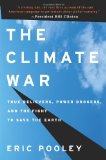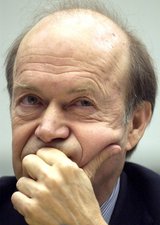
The climate change rhetoric when Obama came to power was exciting. It sounded as if he would lead from the front and the US would soon have a federal cap-and-trade system. “Delay is not longer an option. Denial is no longer an acceptable response.” Certainly we have seen an end to denial from the White House. But we are still waiting for an end to delay, and increasingly it looks as if we’ll be waiting for a long time. Why?
Eric Pooley’s book The Climate War: True Believers, Power Brokers, and the Fight to Save the Earth sheds a good deal of light on why it is that America, in spite of all the scientific evidence that demonstrates the threatening reality of climate change, is still unable, and often unwilling, to mobilise itself to address the danger.
The author is an accomplished journalist who has spent hundreds of hours over the past three years interviewing some of the players in America’s painfully slow progress towards climate change legislation. The result is an illuminating story of battles in an ongoing war which is far from conclusion. It’s told painstakingly but with a narrative verve that carries the reader along irresistibly through its mass of detailed accounts. It’s compelling reading, from which I’ll mention just a few examples.
The Environmental Defense Fund (EDF) is the climate change group to which Pooley devotes most of his attention. A large organisation which has been at work for over 40 years, the EDF has long argued for a cap and trade system to tackle CO2 emissions. Its president, Fred Krupp, is focused on partnership with business to bring about political action on climate change and was influential in the formation of the US Climate Action Partnership (USCAP) in 2007, initially a group of ten companies and four environmental groups. Among them was Jim Rogers, CEO of Duke Energy. In typically detailed fashion Pooley recreates the drama of meetings at which were hammered out the conditions on which Rogers felt he could join the Call for Action USCAP planned to issue. It hinged on whether allowance was made for initial free distribution of allowances to utilities like Duke, a sticking point for Rogers.
USCAP may have been looked at askance by many Green groups, but Roger’s involvement didn’t go down well with his colleagues at the Edison Electric Institute either. He was chairman at the time and several CEOs called for him to step down. At the Heartland Institute denier’s convention in 2008 Steven Milloy bitterly expressed his dismay that CEOs would endorse a mandatory cap. “What do you do when the people who represent business and free enterprise have switched sides on you?”
As the Waxman-Hartley bill was developing, the question of emission allowances being free or auctioned remained vexed. Krupp was willing to give way to the companies, maintaining that it didn’t matter. The only thing that mattered was how many allowances were distributed in a given year and how quickly the number was ratcheted down. The declining cap would see to it that coal use declined.
After his close coverage of the tortuous development of the bill, Pooley concludes:
“Of course Waxman-Markey was full of flaws, compromises, and reluctant nods to political reality. But the bill got right a lot more than it got wrong. By giving carbon allowances to electric distribution companies and requiring them to pass the value on to customers, it used the cap and trade mechanism to address to genuine cost imbalances between regions of the US – making the system fairer and helping the very heartland people who most wanted to see the whole thing wither and die.”
Pooley recognises that the intransigence of the Republicans meant that the bill reflected negotiations only between the left and right wings of the Democratic party, not between the left and right wings of America. “Like a wounded animal, the GOP’s only reflex was to lash out. Anything Obama was for, they would be against.” It’s a sad commentary on a party which has too often allowed itself to be informed on global warming by the organised denial movement which Pooley also takes into his purview.
Al Gore features frequently in the book. His Alliance for Climate Protection organization aimed to spend $100 million a year for three years on advertising campaigns. In July 2008 his Repower America speech challenged the nation to commit to clean energy within ten years. After the elections he sought to orchestrate a large, loud chorus of voices calling on the president-elect and the new Congress to go big and go quickly on the energy front. Some wanted an energy bill first and to leave cap-and-trade for later. Gore disagreed. “If we’re going to have a fight on climate, let’s have a big fight.”
James Hansen enters the picture from time to time. He met with Rogers over a meal. Pooley records each man’s feeling as they left the restaurant. Rogers felt positive: I’m not a confrontational guy, and neither is he. Hansen felt disappointed: This man has a reputation for being green, but he doesn’t really know what it means. His priority is making money.
Pooley records at best mixed messages from the White House. On a good day Larry Summers told USCAP leaders that the stimulus bill needed to be complemented with a cap-and-trade mechanism. “It’s like two blades of a scissors…We need both of them.” But when it came to the Waxman-Markey bill, chief of staff Rahm Emanuel and senior adviser David Axelrod wanted to stick to the clean energy message and leave climate policy to Waxman. Pooley tells of the committed greens in the White House being defeated time and again by those in the political and economic teams who consider voters don’t care about climate action enough for the president to fight for it. The president who we expected to lead on the issue remains strangely constrained.
Obama went to Copenhagen having failed to move a climate bill. Pooley credits him with an honest, even heroic, attempt there to break the deadlock by bringing the major developing nations to the climate table. His speech offered welcome straight talk on the science, though little on the necessary action to address it. But the possibility of a triumph at Copenhagen had already been ruled out by his decision at home not to mount an education campaign on climate science and clean energy jobs to counter the sceptics, and the failure to put a top-level aide in charge of the international climate issue.
Pooley ends with questions:
“Alexis de Tocqueville long ago said that in the US, events ‘can move from the impossible to the inevitable without ever stopping at the probable.’ Was that still true? How bad did things need to get before the moment came? Would the prospect of a clean energy economy, and the jobs it would bring, mobilize enough people to make a difference? Or would some sort of monstrous, galvanic weather event – epic heat and drought, Katrina on steroids – be needed to shake America fully awake?”
They seem to me open questions. After following through the labyrinthine processes the author describes by which anything happens, if it happens, in the American political system and recognising the blinkered self-interest and sometimes sheer malevolence that seems to motivate many of the players, I found it hard to credit that America is on the verge of significant progress. But I took what comfort I could from Pooley’s final brief paragraph where he imagines that the campaigners refused to be paralysed by the questions posed, “splashed some cold water on their faces, ran their fingers through their hair, threw back their shoulders and marched toward the sound of the guns”.
[Buy at Fishpond (NZ), Amazon.com, Book Depository (UK)]
Like this:
Like Loading...
 New Zealand’s leading right wing blogger, National Party spinmeister and opinion poll guru David Farrar, this morning allowed himself the luxury of a rant about the New Zealand Herald‘s coverage of a new paper on sea level during the late Pliocene. In a post teasingly titled “Alarmist bullshit“, he manages to demonstrate his rudimentary grasp of the facts, misunderstands the real story behind the new research, and ends up shooting himself in the foot. Here’s David in full flow:
New Zealand’s leading right wing blogger, National Party spinmeister and opinion poll guru David Farrar, this morning allowed himself the luxury of a rant about the New Zealand Herald‘s coverage of a new paper on sea level during the late Pliocene. In a post teasingly titled “Alarmist bullshit“, he manages to demonstrate his rudimentary grasp of the facts, misunderstands the real story behind the new research, and ends up shooting himself in the foot. Here’s David in full flow:

 Since Don Elder
Since Don Elder  Perhaps serving as defence witnesses will prove a new opportunity for climate scientists to make the clear public statement that the confused processes of the media often muddy. In 2008 James Hansen famously defended the UK protestors, the Kingsnorth Six, who were charged with criminal damage when they climbed to the top of the smokestack at Kingsnorth coal-fired power station in Kent. His role was to provide expert
Perhaps serving as defence witnesses will prove a new opportunity for climate scientists to make the clear public statement that the confused processes of the media often muddy. In 2008 James Hansen famously defended the UK protestors, the Kingsnorth Six, who were charged with criminal damage when they climbed to the top of the smokestack at Kingsnorth coal-fired power station in Kent. His role was to provide expert 